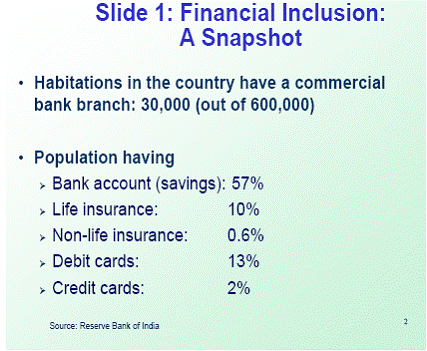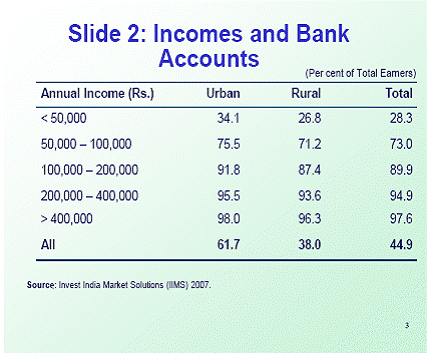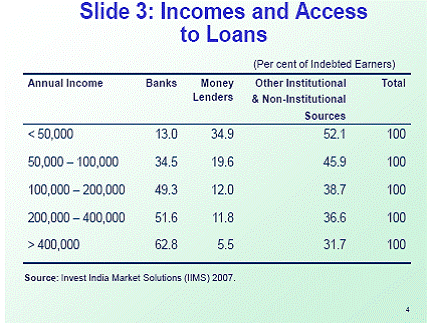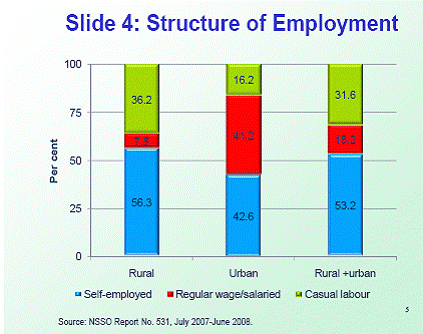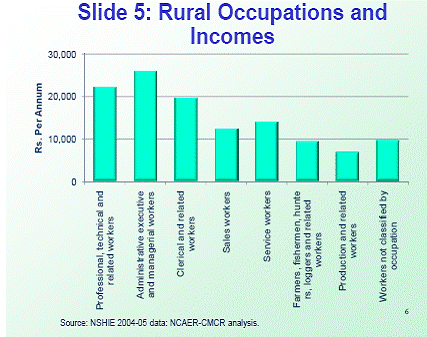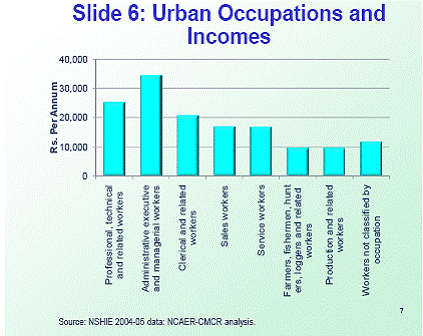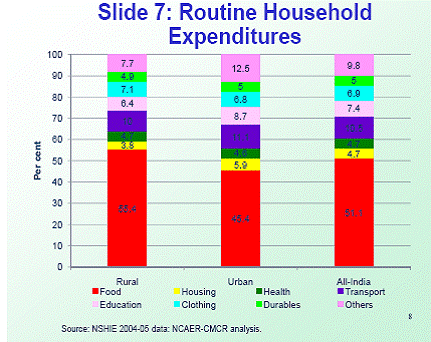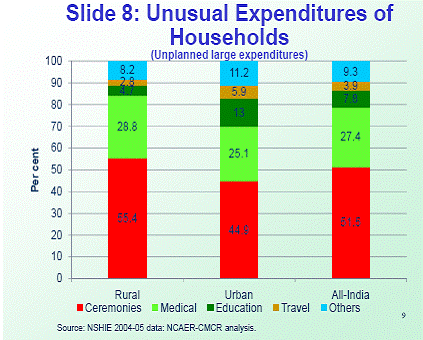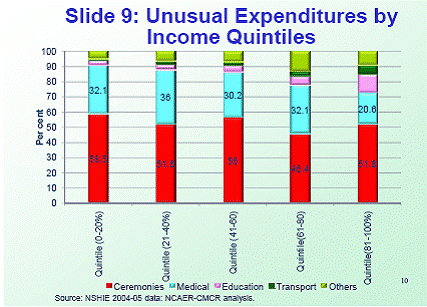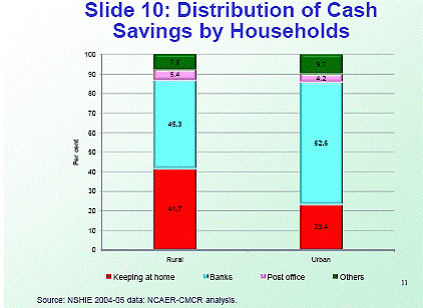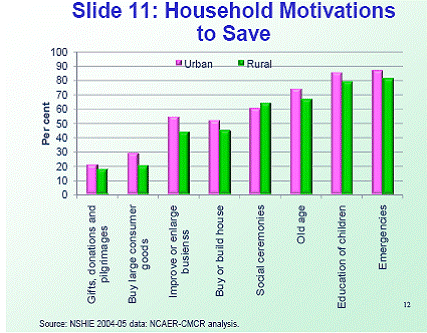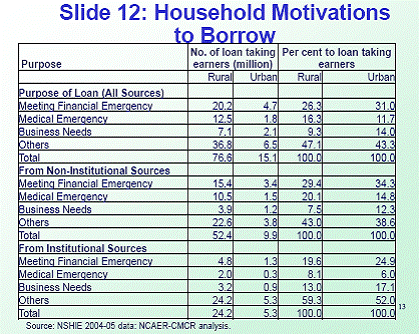 IST,
IST,


Financial Inclusion: A Consumer Centric View
Dr. Subir Gokarn, Deputy Governor, Reserve Bank of India
delivered-on మార్చి 28, 2011
I. Introduction It is a great pleasure for me to be delivering the VIth V. Narayanan Memorial Lecture. I never had the opportunity to meet Mr. Narayanan, but, from what I have heard and read about him, he was clearly a person dedicated to the mission of expanding the reach of and access to banking services in a way which benefitted both the customer and the service provider. As you may know, the financial inclusion agenda has assumed top priority in the Reserve Bank of India’s current scheme of things and the Bank is actively engaging with the financial sector to ensure that the objective of establishing a banking presence in all villages with a population of over 2,000 people is achieved. More importantly, it needs to be achieved in a commercially viable way; banks and other service providers must not see it as a mandate whose burden they have to bear in terms of higher costs and lower earnings. As Governor Dr. Subbarao has put it, financial service providers must see inclusion as an opportunity, not an obligation. This is the issue that I would like to address in this lecture. I will attempt to characterize the potential consumer for financial inclusion products and services, using survey data reported by a number of survey institutions that have been observing the Indian consumer for some time now. Based on these characterizations, I will articulate some key messages emerging for commercially viable financial inclusion. II. The current status of inclusion: an overview Before I begin looking at consumer characteristics, let me provide a quick overview of the current status of access of consumers to financial services. Admittedly, this is not a complete picture, as it does not cover the role and activities of institutions other than banks. I merely want to emphasize the gap that currently exists, which in turn represents the opportunity that the financial sector has to design and deliver appropriate products and services to a very large number of potential customers. Slide 1 provides a set of summary statistics relating to the penetration of various categories of financial products. First, the relatively low penetration of bank branches must be highlighted - only 30,000 out of 6,00,000 habitations have a banking presence. As is well understood, the goal of having a physical banking facility in every habitation is unrealistic, which is why the inclusion strategy is largely based on the use of Information and communication technology (ICT) to expand banking access virtually through the mechanism of a Business Correspondent (BC), who carries a handheld device networked to the bank's systems. This is an enormous technological discontinuity enabled by the spread and efficiency of the mobile telephone network and, clearly, the inclusion strategy must take full advantage of this resource. Even then, we must recognize that there are constraints to the rollout of the BC model, which also needs a certain minimum scale of operation to make it viable. Therefore, the strategy envisages a phased expansion, with larger habitations being targeted first to ensure the viability of as many BCs as possible. In this sense, the phased approach, which first focuses on habitations with populations above 2,000 is based on the acceptance of commercial viability as a key driver of the success of an inclusion strategy. The other statistics on Slide 1 provide some indication of the size of the opportunity. Just because penetration in certain products and services is low does not mean that they represent a natural and automatic opportunity; penetration could be low because there is no demand. It is ultimately a matching of consumer characteristics and the potential demand that is implied by them that allows the service provider to assess the opportunity. However, the statistics presented on the slide do suggest that, apart from savings accounts, which have about 40 per cent penetration, there are several other financial products that might meet existing consumer requirements, such as insurance, which have very low penetration. Similarly, debit cards, which facilitate the use of technology, thereby reducing the dependence of bank customers on physical branches, may help to significantly expand the capacity of the banking network without necessarily setting up more branches. Apart from the aggregate picture, it is also useful to look at the status from the perspective of inequality.Slide 2 and Slide 3 present some data that reveal the differential access that people at different income levels have to the financial system. From Slide 2, it appears that households with an income below Rs. 50,000 (in 2007) find it relatively difficult, or unattractive, to open a bank account. The survey does not reveal whether the relatively low penetration of bank accounts in this income segment is because they can't open them or they don't want them. This is an important distinction, because it implies different actions by banks to improve penetration amongst these households. If access is a problem, then simplified procedures and lower thresholds may be sufficient to achieve the objective and, indeed, this is exactly what is being done by means of no-frills accounts. However, if it is because people don't find adequate value in opening accounts, the challenge of inclusion becomes a little more complicated. Clearly, the mere opening of more and more accounts is not going to achieve the inclusion objective if these accounts are not used as the platform to access a range of financial services that meet the various requirements that the household is trying to satisfy. This raises the issue of product and service design as a critical component of a viable inclusion strategy, which I shall repeatedly come back to during the course of the lecture. Slide 3 looks at the situation with regard to access to loans differentiated by income levels. Here again, the relatively low access of the lowest income group is striking. It is not as though these households do not need credit; if the banks do not meet their requirements, they are clearly accessing other sources. The same question arises here. Are people in this income segment not getting bank credit because they can't or because they don't want to? As in the case of accounts, the answer to this question is critical to devising an effective inclusion strategy. It may underscore the need to look for product design solutions to the problem of low penetration. III. An exploration of consumer characteristics (a) Employment and Earnings Differentials Let me now move on to the core of this lecture, i.e., to characterize the potential consumer for products and services emerging from a financial inclusion strategy. Let me begin with the nature of employment in the country, which, to my mind, is a critical attribute to the kinds of financial services which people may want. Slide 4 provides the composition of the domestic workforce in terms of their sources of income. It is most striking that over half the workforce is categorized as being self-employed. Of course, this should not come as a surprise, as the majority of services we consume on a day-to-day basis are provided by people who logically fall into this category. Another significant proportion falls into the category of casual labour. Only a relatively small minority is placed in the category of regular wage or salary earners, of which a relatively large proportion is undoubtedly associated with the public sector. What does this mean in terms of potential demand for financial services? For the self-employed, it clearly means, among other things, the need for a reliable and low-cost source of working capital, which allows them to optimize on their inventories, if they are occupied in trading activities or acquire productivity-enhancing and service-enhancing assets, which have relatively short payback periods. We all have seen how, first, pagers and, then, cheap mobile telephony completely changed the economics of self-employed service providers. This, of course, happened at an aggregate level, but as we look deeper into the business models of different self-employment categories, I am sure we will discover sector-specific opportunities to make similar productivity improvements. Discovering such opportunities and converting them into a viable lending model is something that the financial sector may benefit from, both in terms of furthering the inclusion agenda and expanding their revenue and profitability bases. The data presented in Slide 5 and Slide 6 provide a somewhat different perspective on the potential consumer base. In Slide 5 and 6, we see the relative incomes of workers in different kinds of occupations. This differentiation is important because it reflects a number of underlying relationships between educational status, employment opportunities and earning potential. The ultimate goal of development policy, of which financial inclusion is a critical component, is to raise the incomes of as many households as possible in a sustainable way. There is, of course, no iron law which says that incomes earned by all occupations must be equal. Differentials that emerge from qualifications, skills, productivity and value added are all legitimate in a market economy, in which financial incentives drive resource allocations across alternative activities. However, from the policy perspective, we must also be conscious of barriers and bottlenecks, which impede the productivity and, consequently, the earning potential from different activities. As Slide 5 indicates, in rural areas, people with some professional qualifications and those in regular jobs, such as in the administrative sector, earn more than people who are lower down on the skills ladder and those who are self employed. One response to this could be to employ as many people as possible in the former areas. In a sense, this was attempted a few decades ago. It generated benefits, but also imposed costs; in any case, as a strategy, it is inconsistent with the current emphasis on fiscal discipline and the efficient deployment of resources across the economy. The focus must, therefore, be on finding ways in which the earning potential of the other occupational categories can be raised. Access to appropriate financial products and services is surely one of these, even possibly the most important one. Of course, it may not be the only requirement - the silver bullet, so to speak - and it is important for the success of an inclusion strategy to identify the other, complementary requirements. One observation that I can make from my recent exposure to and interaction with rural Self-Help Groups and other livelihood mechanisms is that they face significant challenges in finding and accessing the right kinds of markets for their products, which results in relatively low realizations for their products, thus constraining their earnings potential. To my mind, the general validity of this proposition and its implications for building appropriate complementary inputs into the financial inclusion strategy need to be explored further. Slide 6 presents the same data for urban workers. The pattern is essentially similar to the rural one and much the same set of conclusions can be drawn about the distinction between legitimate sources of earnings differentials on the one hand and those caused by barriers and bottlenecks on the other. The reason I brought the urban picture separately into the presentation is to emphasize the fact that the financial landscape in urban areas is completely different from that in the rural areas. If, indeed, lack of access to financial services is a significant reason for the persistence of earnings differentials in urban areas, then it suggests that a relatively well-penetrated environment is also not delivering inclusion to its potential. If this is the case, then we must be cautious in linking the mere presence of financial service providers with the achievement of financial inclusion. The strategy must go beyond organizational presence to the design of appropriate products and services, a point that has been made earlier in the lecture but can be re-emphasized. (b) Expenditure Patterns Let me now turn to an analysis of how consumers, many of whom can be considered the target segment for financial inclusion, spend their money. Slide 7 presents a picture of households' routine expenditures, the largest segment of which is, understandably, food. The proportion of income spent on food clearly goes down as income goes up, but at the aggregate level, the proportion is significant. But, this is not an issue I want to dwell on here. Let me move on to Slide 8, which displays what have been described as "unusual" expenditures by households, which essentially means that these expenditures are generally incurred, but not on a regular or predictable basis. The pattern suggests that the most significant unusual expenditure by far is on ceremonies. This is followed by medical expenses. The two categories together account for almost 80 per cent of unusual expenditures across all households. Slide 9 is even more revealing. It suggests that, among lower income households, the proportion of unusual expenditures spent on these two activities is even more significant. We have all heard of people whose household budgets are severely stretched, even broken, by expenditure on ceremonies and healthcare. We can perhaps be somewhat dismissive about the first, arguing that this is purely discretionary and the household can work within its resource limitations. But then, who are we to judge the household's perceptions of its social obligations? On the issue of medical expenditures, there is no room at all for such discretion; it usually is a matter of life or death. Given the significance of these two categories of expenditure, particularly amongst lower income households but also in others, can we think of financial products that allow households to meet these expenditures without bearing a crushing burden? The health issue clearly lends itself to a low-cost insurance solution and there has been some progress on widening access to health insurance. But, this needs to be matched with an increase in the supply of health care facilities, not to mention the promotion of low-cost treatments, which can be accommodated by a mass insurance programme. This is another example of the need to visualize complementary inputs, which amplify the benefits of financial inclusion. The need to develop a financial buffer for expenditures related to ceremonies, though more complicated than health insurance, also appears to lend itself to product design. As a lifelong employee of the organized sector, I have had the benefit of being a member of one provident fund scheme or the other. One important feature of all the schemes I have been part of is that they allow me to withdraw a substantial portion of my accumulated funds for expenditures connected with my daughter's marriage (though, not my son's, as I recall). This is, in essence, a systematic investment plan for, among other things, ceremonial expenditures. Products of this nature are already available in the market; the question is, essentially, one of threshold contributions and whether they can be lowered to provide access to large numbers of households, even while giving them a reasonable rate of return so there is sufficient accumulation. (c) Savings and Investment: Choices and Motivations Let us now take a look at the way in which households deploy their resources and what motivates their savings decisions. This should provide a basis for both addressing specific needs, essentially an extension of the discussion in the previous section, and also getting a sense of the limitations on the options households have to deploy their savings. Slide 10 presents a very striking picture. Across all households, the primary channels for deploying financial savings are bank deposits and "kept at home", which presumably includes cash, gold and jewellery. The latter is not surprising, given the earlier data point on the penetration of savings accounts. What may be surprising, though, is the significance of the proportion kept at home. Of course, this may reflect a greater ability to afford gold and jewellery, but the pattern raises a fundamental question. Why do these households prefer to keep their savings in a form that does not optimize on the risk-return trade-off? Putting all (or most) of your eggs in one basket, which is essentially the message from Slide 10, may be an appropriate strategy under some conditions; the complete absence of investment options, for example. But, clearly, at the aggregate level, options are not absent; the Indian financial system offers an increasing variety of alternatives with finely differentiated risk-return profiles, allowing individual households significant opportunities to match their savings patterns with their anticipated requirements. In all probability, these opportunities are also subject to some threshold requirements, which means that households below a certain income and savings level cannot as yet access them. From the inclusion perspective, the challenge is clearly to lower this threshold in a way that does not compromise the commercial viability of the service provider. Slide 11 presents a picture of the motivations that people say drive their savings behaviour. The question obviously allows people to acknowledge as many of the listed items as they want and the responses reported indicate the percentage of households who marked a particular motivation. Although the data reported does not distinguish between households by income, the height of some of the bars clearly suggests that these motivations cut across income groups. Let us focus on the four most frequently occurring responses. Of these four, we have already spent a fair amount of time on ceremonies. The other three are, as might have been quite reasonably expected, are old age, children's education and emergencies. Once again, at the risk of repetition, I want to emphasize the point that, for all these requirements, the Indian financial system currently offers a variety of products and services, but threshold requirements apply, which means that many lower income households whose motivations are the same as those of more affluent ones cannot access the same products and services. One could argue that there are no products and services which can meet these requirements with commercial viability. But this is a proposition that needs to be explored and, hopefully, proved wrong. The essential business-related point I would like to make with reference to savings decisions and motivations is that they must be seen in a dynamic context. In an economy that is growing rapidly, households are also equally rapidly evolving in terms of their consumption and savings choices and motivations. As many successful marketers have demonstrated, a life-cycle approach to the consumer is an extremely effective long-term strategy. A significant proportion of low-income households today will achieve middle income status in a few years. Their choices then will partly be dictated by their experience with service providers during their transition. Service providers who get customers in first, even at relatively low levels of activity, provided that they take a forward view of the relationship, can realistically look at benefitting from the increasing affluence and greater and more complex financial needs of those very customers. (d) Borrowing Motivations Let me now turn to the last of the consumer characteristics that I have on my list. Slide 12 presents data on the reasons why people borrow money. Considering all loans taken by the households surveyed, over 50 per cent of rural households and about 45 per cent of urban households report that they borrowed money to deal with financial and medical emergencies. Business purposes were also significant, but not dominant. Of course, since lending money to enable people to deal with such situations is not the conventional activity of banking or most other formal financial service providers, it is unlikely that this requirement would be met by this category of lenders. The data in Slide 12 validate this conjecture; significantly, the proportion of households who borrowed for these purposes from institutional sources was far less than those who borrowed from non-institutional sources. In fact, what may come as a surprise is how many households actually borrowed from institutional sources for the purpose of dealing with emergencies! This suggests to me that the capacity to meet these requirements exists. Again, it comes back to the question of whether the right kinds of products exist to expand the coverage to households that are currently excluded from access to credit. IV. Key Messages I have tried to introduce into the discussion a number of attributes of consumer behaviour and motivations, which I believe are important inputs into a devising a strategy for commercially viable financial inclusion. These related broadly to the (i) the sources of livelihood of the potential consumer segment for financial inclusion (ii) how they spend their money, particularly on non-regular items (iii) their choices and motivations with respect to saving and (iv) their motivations for borrowing and their ability to access institutional sources of finance for their basic requirements. In discussing each of these sets of issues, I spent some time drawing implications for business strategies by financial service providers. In this section, I will briefly highlight, at the risk of some repetition, what I consider to be the key messages of the lecture. The first message emerges from the preliminary discussion on the current scenario on financial inclusion, both at the aggregate level and across income categories. The data suggest that even savings accounts, the most basic financial service, has low penetration amongst the lowest income households. I want to emphasize that we are not talking about Below Poverty Line households only; Rs. 50,000 per year in 2007, while perhaps not quite middle class, was certainly quite far above the official poverty line. The same concerns about lack of penetration amongst the lowest income group for loans also arise. To reiterate the question that arises from these data patterns: is this because people can't access banks or other service providers or because they don't see value in doing so? This question needs to be addressed if an effective inclusion strategy is to be developed. The second message is that the process of financial inclusion is going to be incomplete and inadequate if it is measured only in terms of new accounts being opened and operated. From the employment and earnings patterns, there emerged a sense that better access to various kinds of financial services would help to increase the livelihood potential of a number of occupational categories, which in turn would help reduce the income differentials between these and more regular, salaried jobs. The fact that a huge proportion of the Indian workforce is either self-employed or in the casual labour segment suggests the need for products that will make access to credit easier to the former, while offering opportunities for risk mitigation and consumption smoothing to the latter. The third message emerges from the analysis of expenditure patterns is the significance of infrequent, but quantitatively significant expenditures like ceremonies and medical costs. Essentially, dealing with these kinds of expenditures requires either low-cost insurance options, supported by a correspondingly low-cost health care system or a low level systematic investment plan, which allows even poor households to create enough of a buffer to deal with these demands as and when they arise. As has already been pointed out, it is not as though such products are not being offered by domestic financial service providers. It is really a matter of extending them to make them accessible to a very large number of lower income households, with a low and possibly uncertain ability to maintain regular contributions. The fourth message comes strongly from the motivations to both save and borrow, which, as one might reasonably expect, significantly overlap with each other. It is striking that the need to deal with emergencies, both financial and medical, plays such an important role in both sets of motivations. The latter is, as has been said, amenable to a low-cost, mass insurance scheme, with the attendant service provision. However, the former, which is a theme that recurs through the entire discussion on consumer characteristics, certainly suggests that the need for some kind of income and consumption smoothing product is a significant one in an effective financial inclusion agenda. This, of course, raises broader questions about the role of social safety nets, which offer at least some minimum income security and consumption smoothing. How extensive these mechanisms should be, how much security they should offer and for how long and how they should be financed are fundamental policy questions that go beyond the realm of the financial sector. However, to the extent that risk mitigation is a significant financial need, it must receive the attention of any meaningful financial inclusion strategy, in a way which provides practical answers to all these three questions. The fifth and final message is actually the point I began the lecture with. It is the critical importance of the principle of commercial viability. Every aspect of a financial inclusion strategy - whether it is the design of products and services or the delivery mechanism - needs to be viewed in terms of the business opportunity that it offers and not as a deliverable that has been imposed on the service provider. However, it is also important to emphasize that commercial viability need not necessarily be viewed in terms of immediate cost and profitability calculations. Like in many other products, financial services also offer the prospect of a life-cycle model of marketing. Establishing a relationship with first-time consumers of financial products and services offers the opportunity to leverage this relationship into a wider set of financial transactions as at least some of these consumers move steadily up the income ladder. In fact, in a high growth scenario, a high proportion of such households are likely to move quite quickly from very basic financial services to more and more sophisticated ones. In other words, the commercial viability and profitability of a financial inclusion strategy need not be viewed only from the perspective of immediacy. There is a viable investment dimension to it as well. V. Conclusion The basic premise of this lecture was that we need to take fully into account various behavioural and motivational attributes of potential consumers for a financial inclusion strategy to succeed. In this sense, it is no different from any business strategy development exercise. Where it does differ though, is in terms of significance. There is clearly an enormous gap when it comes to access to and delivery of financial services. Closing this gap will contribute to enhanced livelihoods through higher productivity, and an improved ability to deal with occasional, lumpy expenditures as well as cushioning the impact of financial emergencies. This is not a matter of a few hundred or a few thousand consumers, but an issue of hundreds of millions. The social costs and consequences of badly conceived and executed inclusion strategy could be enormous. We need to bring all relevant knowledge and experience into the development of the strategy in order to maximize the possibility of it succeeding. Understanding what the potential consumer needs and why he needs it is one such knowledge input; indeed, I have tried to argue, a critically important one. I would like to end by thanking Sastra University for inviting me to deliver this prestigious lecture, to the management of the City Union Bank for their very generous hospitality during our visit to Thanjavur and Kumbakonam and to all of you for coming here to listen to the lecture. * VIth V. Narayanan Memorial Lecture by Dr. Subir Gokarn, Deputy Governor, Reserve Bank of India at Sastra University, Kumbakonam on March 21, 2011. Inputs from Pallavi Chavan, Bhupal Singh and Muneesh Kapur are gratefully acknowledged.
|
పేజీ చివరిగా అప్డేట్ చేయబడిన తేదీ:






